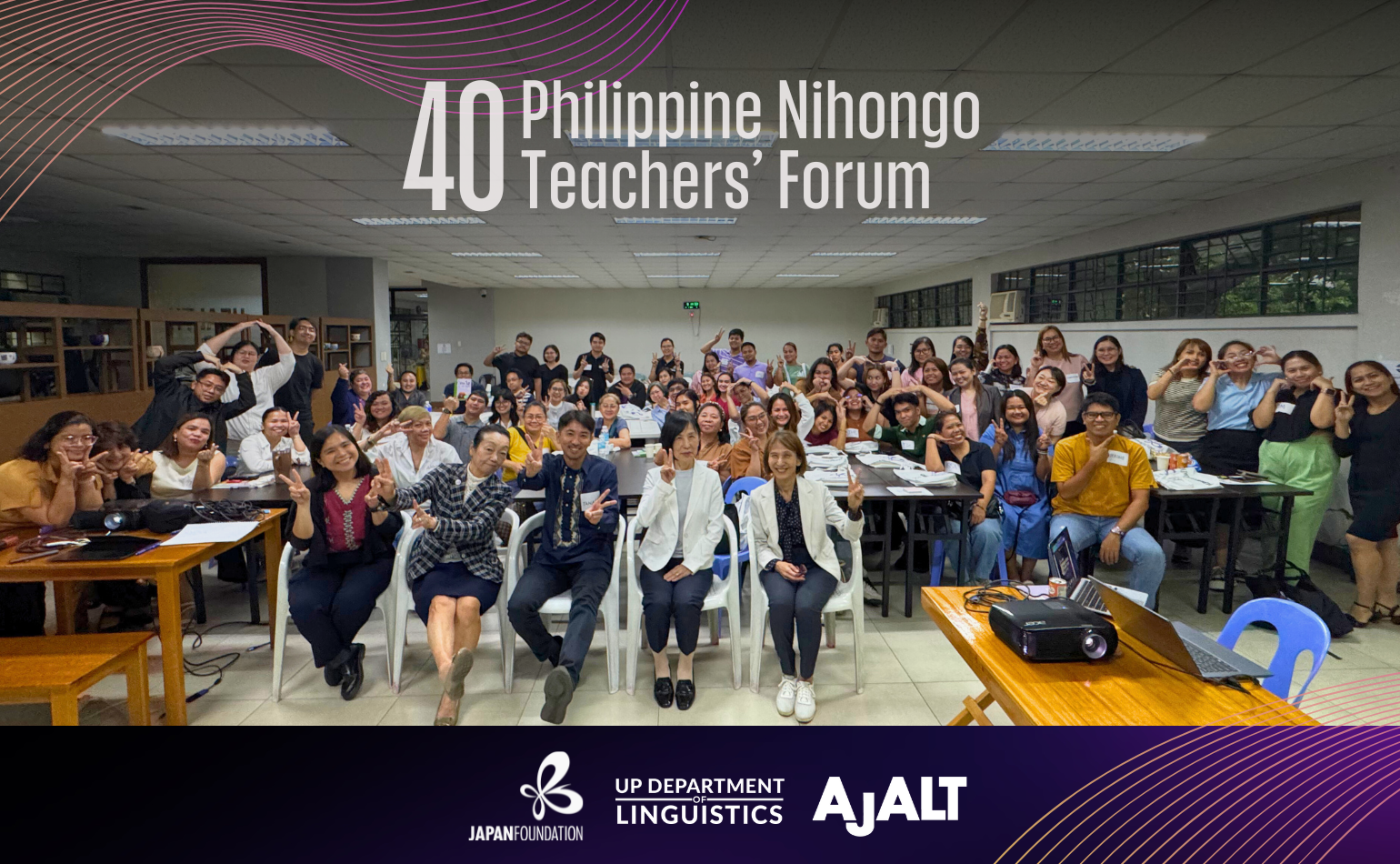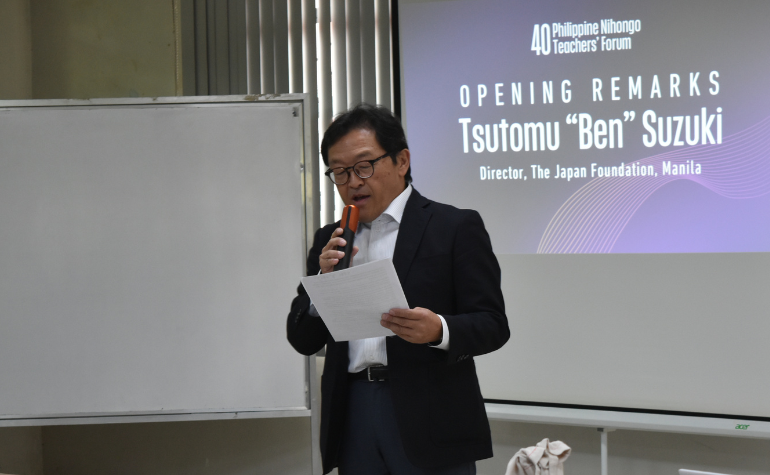
The 40th Philippine Nihongo Teachers’ Forum (PNTF), held last May 30, was an event co-organized by The Japan Foundation, Manila (JFM) and the Department, in cooperation with the Association for Japanese-Language Teaching (AJALT). This gathering of teachers from around the Philippines attests to the three institutions’ collective commitment to fortify local Japanese language education (JLE).

Workshop attendees were welcomed by institutional heads who each expressed gratitude and encouragement to the participants. UP Lingg chair Dr. Maria Kristina Gallego highlighted the idea that teachers are lifetime learners who seek to come up with best learning practices. JFM director Tsutomo “Ben” Suzuki hoped for a renewal of the teachers’ interest in learning and teaching the language. AJALT chair Sawa Toda, meanwhile, signified her excitement for the exchange of insights among the facilitators and workshop participants.


Warming up
To begin, Senior Lecturer Farah Cunanan facilitated activities prepared by the Department’s Japanese language cluster activities that prompted participants to consider Japanese language learning not only from a teacher’s point of view but also from the perspective of students. Participants were subsequently asked how they felt about activities with and without explicit instructions, as well as dealing with variation in a classroom setting. Farah sensei underscored that taking students’ feelings and differences into account helps teachers to innovate and find new strategies and resources to sustain student learning.
She then summed up by remarking that preparing for class is also like preparing for a trip: Despite the unsettling and tough feeling it invokes, teachers can have fun in planning, designing, and developing their classes with clear goals and dreams in mind—primary of which should be to let students travel and eventually flourish as learners.

Workshop 1: どきどきー 感じる・語る、私の場所
The first workshop facilitated by Dr. Miho Tokimoto (Sapienza University of Rome) let participants experience the process of verbalizing personal feelings using multimodal resources. As part of the process of writing mini speeches, participants were tasked to think about the sounds, colors, and feelings they associate with their 私の場所 (watashi no basho ‘my place’), and find ways to describe and explain these to their groupmates. More than just a writing practice, the workshop encouraged teachers to put themselves in the shoes of their students who always ponder on instructions; resort to tools and new media; and need to interact with others. This simulation prompted insights on what usually works and does not work in a pair, group, and even classroom setting, and how these can adequately be addressed.
Moreover, the workshop enjoined teachers to reflect on how such a set of activities differs from what is usually done for vocabulary and grammar practice in textbooks. Responses included insights on the importance of unrestricted and critical thinking; collaboration and connection with fellow students; and having fun while learning and exploring one’s capabilities. In terms of dealing with learner’s anxiety and variation in class, participants agreed that sensitivity and mindfulness are crucial in understanding one’s students and devising approaches to encourage them without invalidating their feelings and thoughts.

Finally, Tokimoto sensei suggested other ways to expand and/or improve the workshop activity, some of which include more elaborate questions-and-answers (Q&As); utilization of other scenarios such as designing a short TV program or writing an email; and incorporation of reading exercises that involve sounds, feelings, and sensory perceptions.
Workshop 2: わくわくー感じる•遊ぶ、音の世界
The second half of the program was a workshop handled by Prof. Sachiko Adachi of AJALT, focusing on how to incorporate songs, word games, and waka (poetry) into lessons across all levels. For this workshop, the textbook Wadaiko, designed for students learning Japanese for the first time, was used.
Adachi sensei first asked the participants to think about how their students fare in terms of pronunciation, and whether teachers provide voice guidance in their classes. She also enumerated some challenges in teaching Japanese, primarily in terms of segmental issues which differ depending on a student’s native language, and prosodic issues faced by all learners regardless of language. She then shared that one key to overcoming those challenges is through “touching the sounds and heart of Japan,” putting primacy on the internalization of sounds and rhythms deemed as the basis of language learning.
Adachi sensei proceeded by briefly recounting her experience teaching student refugees from Myanmar, noting how singing and playing helped in retaining information which is not necessarily the focus of their lessons. From this experience, she realized that various ways of exposing students to language serve as effective tools for education. Remarking that “playing around is the greatest education,” participants were tasked to participate in activities such as listening and repeating what they hear; doing a relay game with numbers in groups; and singing a counting song, among others.

This session ended with a question to ponder: Why are you teaching the language? Adachi sensei also reminded the participants that the activities done in the workshop, a combination of those, and other inclusions featured in Wadaiko (i.e., poems, chants, artworks) can be utilized depending on how teachers envision the achievement of learning outcomes for different sessions. Some Filipino participants gladly commented that the versatility and variety of activities and strategies presented are very appropriate to a Filipino classroom considering how these align with cultural traits (e.g. fondness for singing).
Wrapping up
To formally close the day’s program, JFM deputy director Yojiro Tanaka reiterated the fun that has to be incorporated into teaching and, by extension, learning. He also thanked the organizing committee and the participants for actively contributing to the success of the event.
Overall, the 40th PNTF served as an opportunity to reflect on one’s teaching journey, renew classroom strategies, and relate better to language learners.
Congratulations to the Japanese language cluster for another successful and fruitful event! Special thanks to our two senseis, lecturers Akiko Sunga and Cristopher Dofitas, for enthusiastically interpreting and assisting during the two workshop sessions.
Published by Patricia Anne Asuncion



